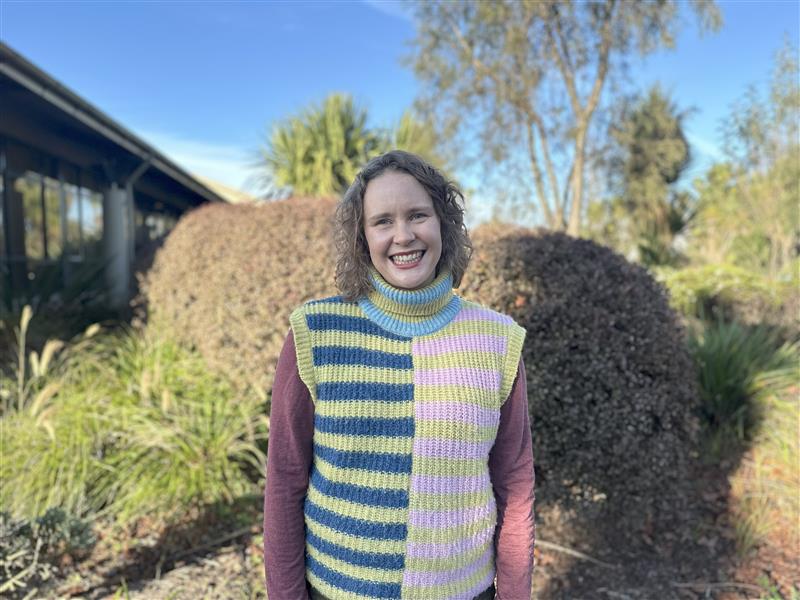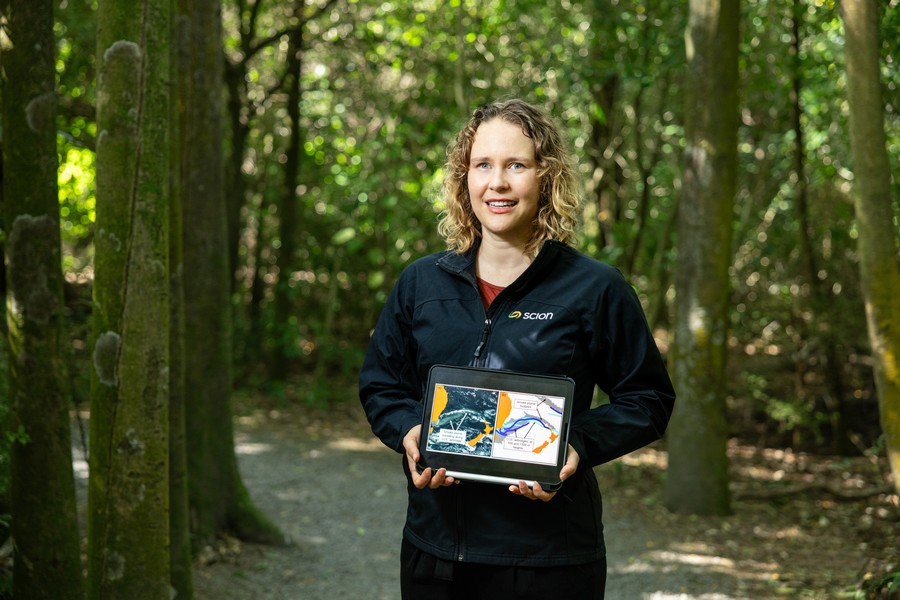
Ilze Pretorius, atmospheric scientist and programme lead of 'Protecting Aotearoa from wind-dispersed pests'.
Every workday brings something new for early career researcher
Atmospheric scientist Ilze Pretorius doesn’t like routine. That’s why her role suits her perfectly.
“No two days – or any two projects - are the same. I can discover new things every day, which is humbling. You never feel like you’re an expert. There’s so much in our beautiful world to learn.”
Ilze, an early career researcher with the Bioeconomy Science Institute’s Scion Group, focuses on atmospheric transport for biosecurity applications. The South African is the science lead of a five-year research programme supported by the Ministry of Business, Innovation and Employment’s Endeavour fund. It is, Ilze says, quite big.
“There’s a lot to look after. There are lots of scientists working in this space and lots of collaborations, so an average day is mostly spent catching up with the different research area leads.
The Protecting Aotearoa from wind-dispersed pests programme aims to predict when and where pests might arrive, using an early-warning system (aerobiological surveillance and prediction – ASaP), which Ilze’s team is developing. It will fill knowledge gaps on aerial invader/pest arrival and survival in extreme atmospheric conditions, giving New Zealand the chance to act before pests take hold to protect the land from unwelcome organisms.
“My responsibility is to make sure all those research areas fit together,” Ilze says. “Every day I've got another focus area where the team and I need to brainstorm solutions.”
She also supports the team in experimental design thinking, does a lot of reporting across the different research areas and is responsible for planning to keep things on track. It’s a busy role. “I also spend a lot of time on planning events and workshops and presenting at conferences.”
Ilze was a finalist in the 2026 Early Career Researcher category of the ScienceNZ awards, in recognition of her hard work and contributions to forest biosecurity science.

No two days – or any two projects - are the same. I can discover new things every day, which is humbling. You never feel like you’re an expert. There’s so much in our beautiful world to learn.
Work and play
Ilze grew up in Johannesburg. She completed an undergraduate degree in geophysics, an honours degree in geophysics and a master’s in meteorology at the University of Pretoria, followed by a PhD in atmospheric sciences at South Africa’s Northwest University.
She came to New Zealand at the end of 2015, largely for – like a lot of South Africans – safety reasons. “In South Africa, it's not that safe to spend a lot of time outdoors,” she says. “To have the freedom made New Zealand an attractive option.
“Just the fact you can as a woman alone go for a run in the forest or on a tramp and not worry about personal safety, and there are such vast areas to explore in the national parks. New Zealand's beautiful – it’s such an amazing place to live.”
As well as tramping in her free time, Ilze enjoys drawing and painting. One of her artworks hangs in Scion’s Rotorua building. She also used to rock climb. She and husband Johan – also South African – met at the climbing wall at the University of Pretoria and have a son, Jansen, who’s just turned two and keeps his parents on their toes.
Ilze’s interest in science started in primary school. “There was a drought in the Gauteng area, and there were strict water restrictions,” she says. “That was when I started thinking about the environment and the fact we are so vulnerable, and I remember forcing my whole family to bath in the same bath water and then watering the plants afterwards with that.
“I think I annoyed my parents a lot now, thinking back,” she laughs. “But I really took it seriously.”
In high school, Ilze read a book called Ishmael by Daniel Quinn, where the main character is a gorilla. That left a lasting impression too.
“He talks to this man about how we ended up in this environmental situation, from the perspective of a gorilla. That put things in perspective for me: how detached from what’s important in the world and how we’ve basically messed up, and that solidified my desire to do something in environmental sciences.
Scion work
Getting the Endeavour funding for the Protecting Aotearoa from wind-dispersed pests programme has been a career highlight for Ilze so far. “It’s not often scientists get the privilege of working on a programme for so long,” she says. “This is an amazing opportunity to build a deep understanding of the work.”
The programme is ramping up this year – it runs until 2028 – and the focus is on getting the ASaP system completed so the New Zealand primary industry can use it.
“I think that's one of the biggest challenges in science today: scientists are so sometimes quite isolated and the work isn’t being used out there where it can make a difference,” Ilze says. “There are always going to be challenges.
“Of all the people that study science, only a very small percentage of people end up doing active research because there's such limited funding. It's important for people to realise that if they’re planning to study science.
“But the benefits are massive. The work is humbling, challenging and fun all at the same time, and it’s an incredibly fulfilling career.
“I'm very happy with the career choice I made.”
